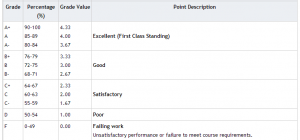by Jessie Key, Teaching Faculty Member, Department of Chemistry, Faculty of Science and Technology, VIU
As a newer teaching faculty member, I find one of the most difficult and time consuming parts of my job is writing and marking exams. By comparison, preparing lecture material seems much easier to me. As a subject matter expert, it is natural for me to present my thoughts and viewpoint on the course material in a clear and understandable format. There are also a lot of resources available in the textbook and instructor resources for preparing lectures. This is not the case for writing good quizzes and exams, if you are lucky the previous instructor(s) may have provided their old exams. However, they may have emphasized different viewpoints on the course material. As well, old versions of exams have a habit of ending up in current students’ hands.
Writing the quiz or test
When writing a quiz or test there are certain factors I try to consider (in alphabetical order):
Clarity of the question: The language used should be clear and understandable, enabling the students to focus their attention on the solution to the problem instead of wondering what the question is asking. Sometimes including what units the answer should be expressed in, or how many points they should include in their explanation can make a question much clearer to the student.

Difficulty level: I find selecting the right mix of questions at the right difficulty levels is one of the most challenging aspects of writing an exam. It is easy to write an exam that everyone aces or that everyone struggles with. Hitting that sweet spot where everyone is challenged and students’ knowledge levels are demonstrated with that perfect Gaussian distribution is difficult. At VIU we use a fairly standard grade scale (see image to right), where around a C+ is the average grade.
Ease of marking: Sometimes spending 30 minutes incorporating ‘ease of marking’ design elements into the exam can save you hours of marking.

Mentioned before in ‘Clarity of the question’ including additional instructions can focus student responses and give less extreme answers. I am a big fan of using boxes where students place their final answers. This provides structure and saves time searching about the page for their answer (see image to right).
Level of understanding demonstrated (types of questions): An exam should provide a forum where students can demonstrate more than just their ability to regurgitate information. Unfortunately many students enter my class with study strategies that focus primarily on memorization and regurgitation. I try to incorporate a mixture of multiple choice, short answer and long answer questions. Each of these question types can demonstrate understanding at different levels of Bloom’s Taxonomy (http://en.wikipedia.org/wiki/Bloom%27s_taxonomy) (See image below).

Time available to the student: A common complaint I receive from some students is that there wasn’t enough time to write the exam. Yet, for the same exam I will have other students hand in the paper twenty to thirty minutes early. There is no easy answer as to how much material to include and how much time to give students. Some will suggest that multiplying the time it takes you to complete the exam by three or four is a good starting point. Adjusting the number of questions or time allotted is a balancing act, and honestly I probably lean more towards challenging the students for time. The student’s abilities to assess their own knowledge of the material and what the questions require should allow them to prioritize and manage their time. These are important skills to develop, that will pay off outside of the classroom. In the real world, missing deadlines or not completing important tasks can equate to a more serious penalty than a few marks lost.